 |
What Every Paraprofessional Needs to Know |
0.75 |
In this course, you will learn what a paraprofessional is. This course goes over various topics that paraprofessionals need to know. There is an emphasis on the instructional paraprofessional that works in the classroom, but this course is designed to educate ALL paraprofessionals. |
 |
What's Bugging You? Communicable Diseases |
0.17 |
This course covers common communicable diseases, how they enter the body, and how certain policies can aid in lowering the likelihood of transmission. |
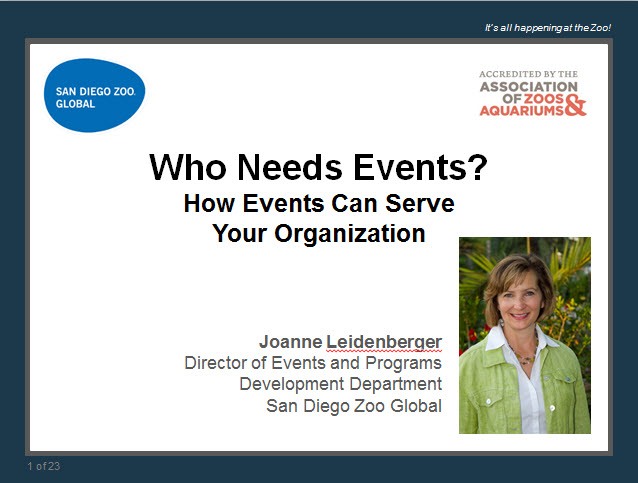 |
Who Needs Events? How Events Can Serve Your Organization |
1.00 |
This course will cover the various types and purposes of events that San Diego Zoo Global produces and relate how similar events can serve your organization. Presentation will cite specific examples and provide event tips. |
 |
Whole Child Approach |
1.25 |
This course covers the Whole Child Approach. It is just one out of many education courses we offer. This course will help you develop new knowledge about the Whole Child Approach and why it is significant in education. It will teach the importance of character development, social and emotional learning (SEL), personalized learning approaches, interventions, and assessments. This course will also explain culturally responsive teaching and how parent and community engagement is crucial to students' success. |
 |
Wildlife Ambassador Management |
2.00 |
Wildlife Ambassador Management will review the range of program animal roles in zoos and aquariums, the risks and rewards, the challenges and the considerations necessary for a program that follows best practices. The class will focus on animal acquisitions, animal handling policy, management practices for meeting the program animal’s social, physical, behavioral and nutritional needs as well as the safety of the animals, guests, and staff. |
 |
Working Safely with Dangerous Animals |
2.50 |
This course is designed to teach the important foundation of working safely with dangerous animals. You will learn general strategies for working safely in a zoological environment as well as specific strategies for managing and working with the great apes, venomous and large reptiles, large carnivores, and ungulates. These topics are essential for working safely and preventing injury in a zoological environment. |
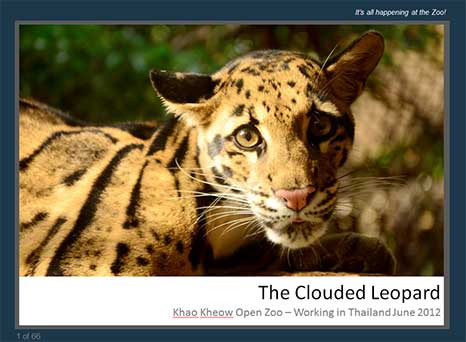 |
Working with Clouded Leopards in Thailand |
1.00 |
The clouded leopard is a charismatic and shy big cat native to the jungles of South East Asia. There are only 277 clouded leopards in a managed environment worldwide. In this presentation we go to the Kheow Khao Open Zoo in Thailand to work with 34 clouded leopards housed at the Clouded Leopard Breeding Consortium. We will learn about the hands-on strategy used in breeding two very different pairings of clouded leopards. Visiting the native country of the clouded leopard will not only broaden your perspective and your base knowledge of the species but will also teach you about the customs, culture and climate of their native habitat. |
 |
Working with Minors |
2.00 |
This collection includes Reporting and Abuse Laws, Campus Policies, Developmental Differences and Establishing Boundaries. |
 |
Workplace Basics |
1.00 |
Starting a new job is intimidating enough, even more so when you are confused about how the basic workplace functions. This course will take you through the most essential things to know. This way, you can become the most successful worker possible. |
 |
Workplace Injury and Illness Prevention Programs (IIPP) |
1.00 |
This course covers employers' responsibilities in establishing, implementing, and maintaining an IIPP. It also outlines steps in developing an effective program that helps ensure the safety and health of employees while on the job. This course is designed to help employers provide better workplace protection for their employees and reduce losses resulting from accidents and injuries. It is to provide guidance rather than prescribe requirements and is not a legal interpretation of any state standard. |
 |
Workplace Violence Prevention (California) |
0.50 |
This course covers workplace violence incidents and workplace violence prevention plans. In order to prevent and mitigate workplace violence incidents you will learn about typical violence hazards, how to assess and evaluate risk factors, and the threat workplace violence poses. Workplace violence prevention plans (WVPP) are important guides for the office in the event of a violence incident. In this course, you will learn how to set up an effective WVPP and get employees involved to ensure the WVPP can be most effective. |
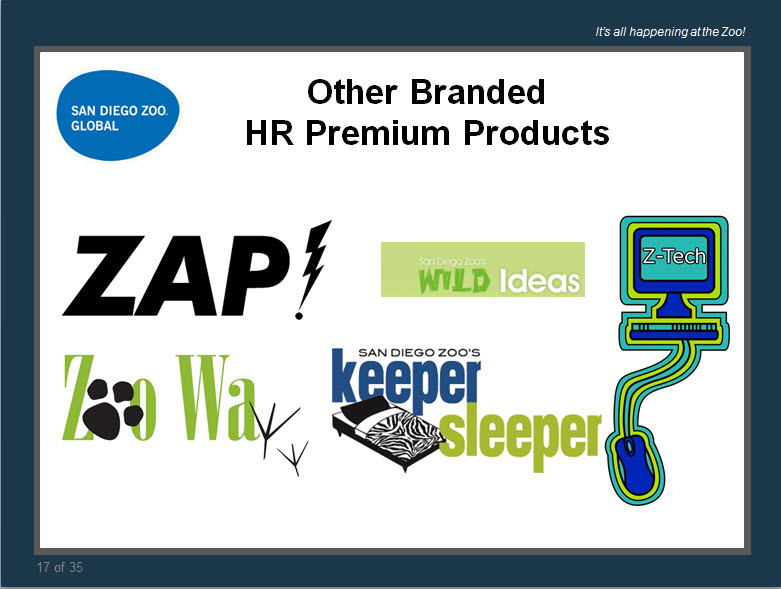 |
World Class Innovations in Human Resources |
1.00 |
This is one webinar any HR professional/organizational leader will not want to miss. Chief HR Officer of the World Famous San Diego Zoo, Tim Mulligan, will share some of the newest innovations in the ever-changing HR landscape - including employee product branding; creating a Leadership Brand; innovative ways to reward and recognize; and how to foster innovation within your organization.
|
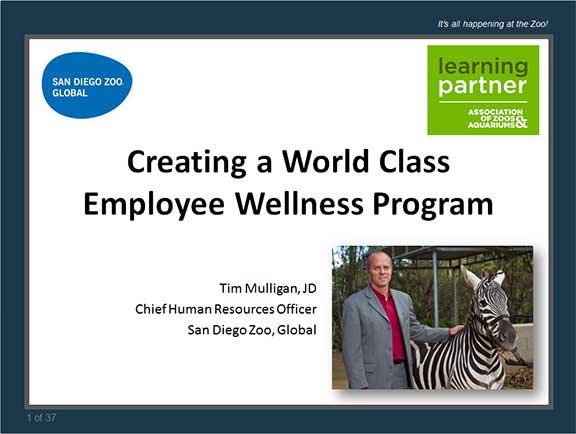 |
World Class Wellness |
1.00 |
In 2011, San Diego Zoo Global rolled out the "Roar Longer" program, a comprehensive workplace wellness program. For two years, this program has successfully taken engagement, productivity, and health minded thinking to another level. In this webinar, Tim Mulligan, Chief Human Resources Officer for San Diego Zoo Global, will teach participants the tricks of the trade in building a results-oriented wellness program. |
 |
Worms, Germs and You (Introduction to Zoonotic Disease) UPDATED |
0.50 |
Worms, Germs, and You is an introductory course to the basic principles of zoonotic disease education and disease prevention. You will learn about some basic disease biology and terminology, as well as a variety of prevention techniques to be applied at work and at home. Finally, a few zoonotic disease examples will reinforce lessons learned and help you apply some of this information to real disease scenarios. When remembered and practiced, the material in Worms, Germs, and You will greatly decrease your chances of contracting a zoonotic disease.
|
 |
Writing Skills |
0.50 |
In this course, you will learn how to develop your writing abilities by pursuing inspiration, practicing writing business letters and emails, differentiating between active and passive voice, and more. |
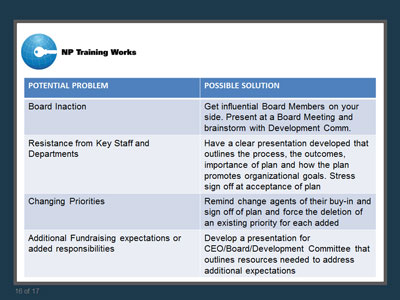 |
Writing the Annual Development Plan |
1.00 |
The key to success in any Development department is having a solid plan. Development Planning helps you stay on task and stick to your goals when everyone is pulling you in multiple directions. Planning also gives you the option to be flexible when necessary. In this Webinar you will learn the key elements of a successful Annual Development Plan and have a toolkit for your own planning. This Webinar will help you: understand the development function and how it interacts with, and relates to the functions of other departments; create a development philosophy that guides your overall vision for success; set development goals; create action plans for each area of responsibility within the development function; create donor contact plans; understand the various development categories and identify the categories you are responsible for in your organization; and, identify material needs for your development office, download examples of materials and edit them for your own use.
|
 |
Young Worker Safety Training |
0.75 |
This course covers federal laws regarding working minors as well as common workplace hazards. |
 |
Youth Development Trends: Focus on Older Youth |
2.00 |
The Center for Early Adolescence at the University of North Carolina and the Search Institute have found that early adolescence is a time of rapid change in youth development and developmental needs. For many children, the characteristic needs of early adolescence begin to emerge as early as age nine, when children are still in elementary school and attending traditional OST programs. OST professionals who understand these emerging needs are better equipped to create successful program experiences with older children in their programs.
The number of quality OST programs for children between five and twelve is steadily growing across the country. At the same time, there is increasing public interest in establishing programs that can also address and support the out-of-school needs of children over age twelve. For many years, communities tried to meet the needs of older youth by a problem-solving approach that focused on helping youth by fixing what was wrong. New trends in youth development take a more positive approach and are focused on working with youth to create positive outcomes.
OST professionals who are knowledgeable about adolescent development and developmental needs and are knowledgeable about youth development research and trends can play important roles in helping their communities design and develop the next level of program services for children over the age of twelve. By learning about ways to support the developmental needs of older youth, OST professionals can join with others to create strategies and programs for continuing to build on the positive experiences younger children have in their OST programs. |
 |
Youth Development Trends: Focus on Older Youth (Collection) |
2.00 |
The Center for Early Adolescence at the University of North Carolina and the Search Institute have found that early adolescence is a time of rapid change in youth development and developmental needs. For many children, the characteristic needs of early adolescence begin to emerge as early as age nine, when children are still in elementary school and attending traditional OST programs. OST professionals who understand these emerging needs are better equipped to create successful program experiences with older children in their programs.
The number of quality OST programs for children between five and twelve is steadily growing across the country. At the same time, there is increasing public interest in establishing programs that can also address and support the out-of-school needs of children over age twelve. For many years, communities tried to meet the needs of older youth by a problem-solving approach that focused on helping youth by fixing what was wrong. New trends in youth development take a more positive approach and are focused on working with youth to create positive outcomes.
OST professionals who are knowledgeable about adolescent development and developmental needs and are knowledgeable about youth development research and trends can play important roles in helping their communities design and develop the next level of program services for children over the age of twelve. By learning about ways to support the developmental needs of older youth, OST professionals can join with others to create strategies and programs for continuing to build on the positive experiences younger children have in their OST programs. |
 |
Youth Development Trends: Focus on Older Youth: Developmental Needs |
1.00 |
The Center for Early Adolescence at the University of North Carolina and the Search Institute have found that early adolescence is a time of rapid change in youth development and developmental needs. For many children, the characteristic needs of early adolescence begin to emerge as early as age nine, when children are still in elementary school and attending traditional school-age care programs. School-age care professionals who understand these emerging needs are better equipped to create successful program experiences with older children in their programs. In this course, we will explore the developmental needs of older youth. |
 |
Youth Development Trends: Focus on Older Youth: Programming Approaches |
1.00 |
The Center for Early Adolescence at the University of North Carolina and the Search Institute have found that early adolescence is a time of rapid change in youth development and developmental needs. For many children, the characteristic needs of early adolescence begin to emerge as early as age nine, when children are still in elementary school and attending traditional school-age care programs. School-age care professionals who understand these emerging needs are better equipped to create successful program experiences with older children in their programs. In this course, we will examine programming approaches that address the needs of older youth. |
 |
Zoo Exhibit Design: Past, Present and Future |
1.00 |
This presentation will give a brief history of zoos and animal exhibit design, discuss the theories behind modern exhibitry and the process for implementing them, and will end with a look at where exhibit design is headed in the future. |
 |
Zoological Record Keeping |
2.00 |
Keeping accurate animal-care records is an important part of zookeeping and a requirement for AZA accreditation and permitting. Standardized information systems that can be transferred and maintained collaboratively between organizations can help you identify health issues, develop sustainable species populations, and address conservation challenges. Using a case study from a zoonotic disease concern at the San Diego Zoo, you will learn the basics of record keeping, including standard abbreviations, animal identification systems, best practices in reporting, and a list of record types every accredited facility should maintain. |
 |
Zoom Meeting Basics |
0.50 |
Zoom is a web-based video conferencing tool with a local, desktop client and a mobile app that allows users to meet online, with or without video. Zoom users can choose to record sessions, collaborate on projects, and share or annotate on one another’s screens, all with one easy-to-use platform. In this course we will go through the major features of Zoom Meetings. |
 |
Zoonotic Disease and Biosecurity |
2.00 |
Every year, zoological organizations are faced by new challenges in maintaining the health of their animal collections. Zoonosis, or disease that can be spread between species, forms one of the greatest threats to the safety of animals, guests, and keepers. Using a case study from a zoonotic disease concern at the San Diego Zoo, you will learn the basics of zoonotic disease identification and prevention, including standard record keeping, best practices, health and safety protocols for keepers, and the understanding of how disease can be spread. |


























